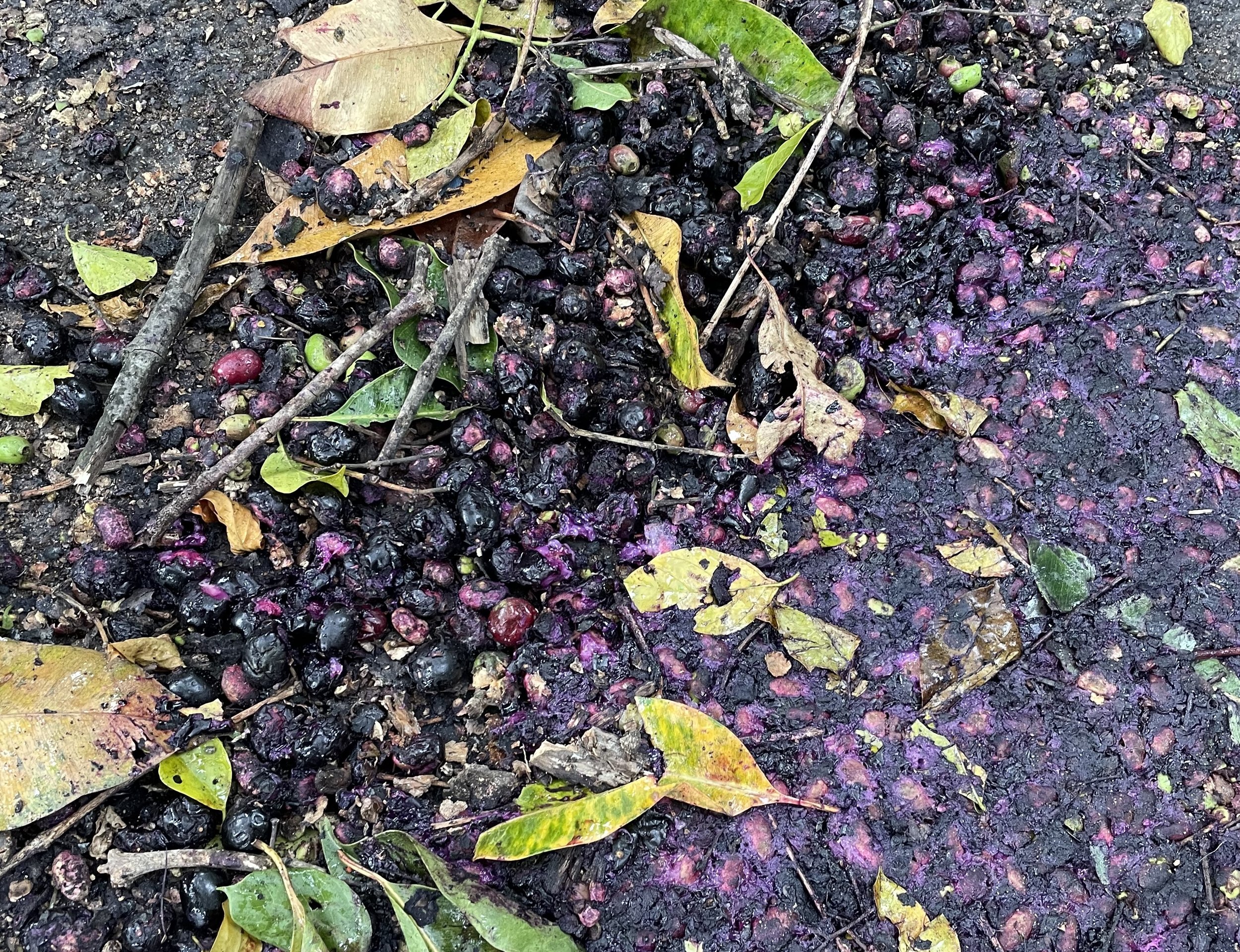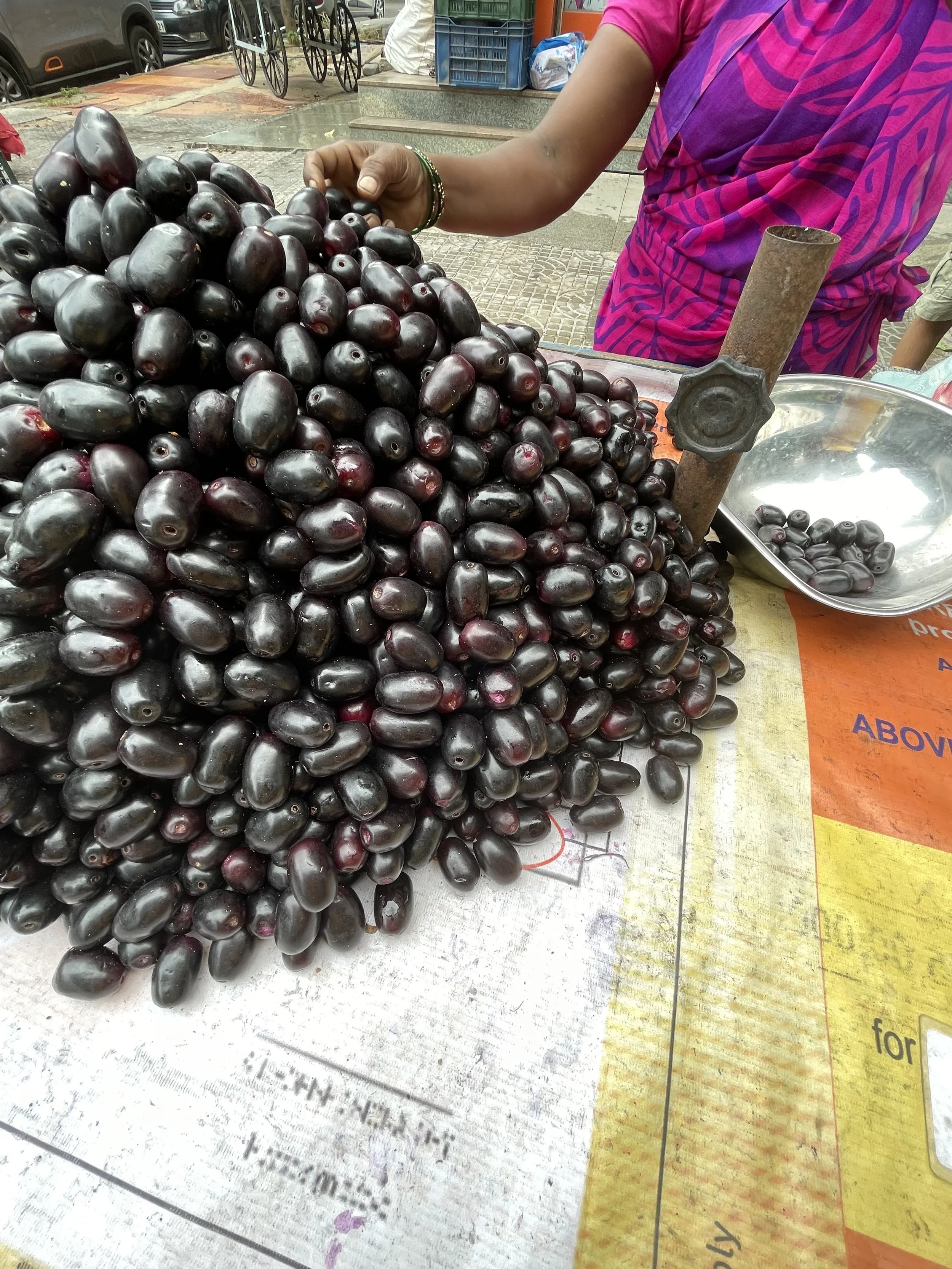Black Plums and a Purple Heart
Photo: Babli Yadav
Personal Essay: ‘Ten minutes into our ride, we land upon this road patch with grave signs of purple. Hundreds of fallen fruits of an old jamun tree, squished, squashed, and beaten by the dance of the July winds.’
For most of my life, July was the month of oblivion for me. It existed, and yet, it didn’t.
Until, on one such July, my father passed away. Now, my subconscious mind and sleepless heart continues to associate the month as the time of grave endings.
And as the month of Jamuns.
One July afternoon of 2023, I picked up my son from school, and the two of us went on a stroll around the empty lanes of Bangalore. “Mumma, ghar nahi jaana,” he insisted. Mom, I don’t want to go home. So, we decide to go for a ghummi-ghummi, our code for a very slow, two-wheeler ride. We go past unknown by-lanes flanked by beautiful houses on each side. He gawks at the cars parked outside and I look at the avenue trees. This is our little time to get lost from our usual routine, and not be found for a while.
Ten minutes into our ride, we land upon this road patch with grave signs of purple. Hundreds of fallen fruits of an old jamun tree, squished, squashed, and beaten by the dance of the July winds. As I walk around to inspect the scene, my shoes move with a certain guilt. Of stepping over bodies which could have been alive seconds ago.
I turn my gaze to the tree canopy; clusters of fruits—ripe and unripe—clutching on innocently to their mother’s fingers. Like most sensible mums, this one too, holds tightly the grip of the newest born, and slowly starts loosening it around those ready to leave her high shelter.
There is a slight afternoon drizzle, followed by strokes of unruly wind, which make it difficult for the mature souls to keep hanging on. They must exit their mother’s home now and find their own fate.
A few seconds later, the unforgettable squishing sound of falling fruit meeting ground hits my ears. Death of any kind brings many reminders: unpleasant and otherwise.
*
A huge jamun tree stands in my small village Nagla Kanholi in Uttar Pradesh. It is situated right in front of our family home, which my father built along with his two brothers. Decades ago, with great difficulty and after much extended-family feud, the house earned itself a boundary wall. The jamun tree borders this wall—but not on our side.
Many of my childhood summers in the 90s were spent around this tree. During afternoons—while grandmother, mother and aunts treated themselves to a nap during peak sweaty, no-electricity summers—the siblings and first cousins first climbed the short boundary wall and then the jamun tree. Its leaves offered us a much-needed gentle breeze, but the tree wasn’t ready to fill our stomachs yet.
If spring and summer was all about the mangoes, summer leading into monsoon brought some purple in the villagers’ life.
He aims for the head and heart of the body and smashes the stick on it. Maybe it is the sound that he likes, of leftover life leaving the body. Or the faint purple-pink colour that the dark, outer skin exposes when torn apart.
I could never call myself a ‘villager’ however, despite being born in one, frequenting it from time to time, and reliving it through my memories for years. I could never wholly call myself a city person either, for a piece of me always wished for a return to humbler, rural life. It feels as if I spent my whole life in transit. From one city or town to another; calling every place my own and yet, not calling any of them mine.
As a growing girl, home was transit accommodations, army quarters, 24-hour journeys in train bogies, the humble abodes of our relatives, and a 2-bhk apartment (our very own, finally). Home became wherever I spent time with my family.
All these places now remind me of the father I have lost.
I don’t remember ever tasting a fruit from the jamun tree that breathed near the boundary of my ancestral home in U.P. I don’t remember spending any of my summer vacation there after turning 15. But as a child, I remember running around it, sitting on it, staring at its canopy.
*
“Mumma, look what I found.” In an unknown by-lane of Bangalore, my son has a fat, broken stick in his right hand. He calls me close, and with some pride, shows me the dead bodies he has further mauled.
I feel hurt, but I’m not surprised. What could he know of his mother’s pain, of watching hundreds of very organically grown fruits, fallen from grace, dead and wasted. Run over by cars, scooters, morning joggers’ thumping feet. What could he know of a fruit that he has never tasted in six-and-a-half years of his life?
I am with him, physically, while he shows me motionless signs of his accomplishment. He aims for the head and heart of the body and smashes the stick on it. Maybe it is the sound that he likes, of leftover life leaving the body. Or the faint purple-pink colour that the dark, outer skin exposes when torn apart.
From where I stand, I see that the tar black road and the purple bodies have almost merged into one other. Should we call this the ‘Jamun Lane’ out of sheer respect to their martyrdom? At least while the showers last.
A couple of lanes from this one, fruit carts stand with batches of neatly stacked jamun fruit. The privileged lot. Cultivated and harvested with a clear purpose. All up for sale, for ₹160 per kilo. We decided to purchase some from here for later.
I think about the lessons from my son’s kindergarten years. This is the way we wash our fruit. Wash our fruit. Wash our fruit…
Don’t call me a hypocrite yet. I had tried picking a few from the Jamun Lane, but who survives a fall from a 60 feet tall tree? I wonder if the tree knew that her children would certainly land upon a rough, miserable fate, would she still have let go?
This could have been avoided, I feel—this explicit show of death. If beneath the tree canopy lay, not a tar, city road but gentle earth soil. Nature is kinder than man. The winds would have still blown the fruits away but they would have fallen on a cushiony layer of mulch or forgiving soil. If not anything, the seeds would have pierced through the earth and made it home. An all new jamun tree, regenerating, years after years.
Jamun as a fruit cannot be chopped. The mouth has to open its doors fully and take it in for what it is. Then the teeth, like excavators in a blind cave, dig into its very dark, outer flesh. The tongue takes over from here, swirling around the hardy seed, calculatedly extracting and supplying what is left of its juicy body. Soon, the mouth is on its way to inspect the outdoors; a very narrow opening, enough to blow out. And there it is, a fool-proof, man-made, seed dispersal technique.
In cities, the seed appears and vanishes with the rain. It is seldom allowed to go deeper, to be one with nature, to turn into a sapling or a tree, to feed the thirst of a worm breeding underneath or replenish the soil.
*
A few years ago, while on a holiday in Goa, my partner and I along with our son stayed over in a village called Batim. The village had a few unattended heritage homes, transformed into Airbnbs by the current generation. They knew how to pocket guests at an asking price.
Batim had a poi bakery: local bread made in a woodfire oven, and then distributed and sold around by a man on a bicycle. Batim also had a cemetery, a church, a lake, and lots of trees. It was a blessing that the beach was a little far from where we stayed; we could focus on other important things that Goa had to offer.
One evening, while looking for some me-time, I decided to cycle around the village. I rode through a dense, forest-like patch, feeling scared and joyed at the same time. A few minutes into the ride, I realised the secret behind the density of that part of the land. It surrounded the village cemetery.
In one way, the dead ensure that not all of earth is invaded by concrete.
In the afternoons, she sits under the tree and watches little kids come by and pick the fallen fruits. She tells me that the cool breeze rushing past the jamun tree helps keep her calm.
There was a sinister feeling to this place. Soon, I landed upon a home with a small gate and a smaller boundary wall. My slow-paced ride allowed me just enough time to catch a glimpse of what was happening behind the wall.
A mother and her daughter stood there with a big piece of cloth in their hands. Daughter to the left and mother to the right. A strange way to dry clothes, I wondered. But this was an unknown village in Goa, and I was curious to know more. Upon walking in with touristy confidence, embellished with a genuine smile, I was told they weren’t drying anything; in fact, they were harvesting jamun fruits from the tree. The fabric was supposed to catch them before they hit the ground.
Only then, my eyes went up to the middle-aged tree. A young boy had climbed high up the trunk and was gently shaking the fruitful branches.
My purple joy knew no shame. I politely asked for a share in their hard work. Very sweetly, the mother obliged. Within me, a voice mimicked the people in my life who would’ve mocked my natural instinct. How can you ask like that? they would’ve said. But I did, and I was glad I did.
Neither my partner nor the little one wanted to taste the fruit. They didn’t know jamuns the way I did.
*
Somewhere around 1997-98, my family, then living in Ahmednagar in Maharashtra, took a trip to Shirdi. This is a holy place dedicated to Sai Baba, a saint that many in India deeply store their love and faith in. There were five of us: father, mother, my two younger brothers, and I. We travelled in a local bus—my father never got around to owning a car.
I faintly remember feeling hungry during the two-hour journey. My father offered me a batch of freshly bought jamuns. How could he know that I held zero self-control when it came to the fruit? I ate and ate, one after the other, each bite of its fleshy, tender skin. Sweet, tangy, tarty. At one point, I teased my brothers with a show of my unusual purple tongue. They weren’t impressed.
I threw up all the purple an hour later. A dizzy headache lingered throughout the trip.
*
Photo: Babli Yadav
Past teenage, adulthood, marriage, and motherhood, I got a chance to revisit the jamun tree of my childhood and our village. It was on the anniversary of my father’s death.
He went quietly in his sleep, and irony, for he was the kind of man who couldn’t stand silence. Unsolicited advice, loud chatters, poetry, songs were his thing. A few days before his passing, he had called to inform me that the tree had grown gigantic and started fruiting fiercely. And how he had picked fallen jamuns off the tender ground and relished them, with mother and other children around.
On the night of July 13th, 2021, I saw my father’s body on a make-shift, bamboo bed under the very same tree. Many, many blooms adorned his neck. His eyes shut. Face, calm. As if still in deep sleep.
The image still makes my spine shudder.
Not all fathers can be remembered on Father’s Day. Whether I choose it or not, July, for me, is Father’s Month.
Little details and happenings begin to transport me back to the times we spent together. His photographs tucked away in a drawer crop up limbs and crawl their way to me. Yellow postcards, blue inland letters, white-red postal stamps he handed over to me, when we met, are literally in my face. His hat finds my head in times of grave need.
I wish I could show him my Jamun Lane.
My mother visits the village home all by herself now, especially during summertime. In the afternoons, she sits under the tree and watches little kids come by and pick the fallen fruits. She tells me that the cool breeze rushing past the jamun tree helps keep her calm.
The next time when she visits me here in Bangalore, I’d like to show mother the jamun saplings growing in my terrace garden. Four of them are nearly three feet now.
The pieces of land my father owned in Nagla Kanholi go to my brothers. But if I ever have my own piece of land—one that I get to call my home—I will plant the saplings from my terrace on its premises. And there won’t be a boundary wall.
***
Babli Yadav is a freelance writer of Hindi poetry, non-fiction essays, and news articles on human interest angles. She is based in Bengaluru, India. You can find her on Instagram: @scribbler_bee.


